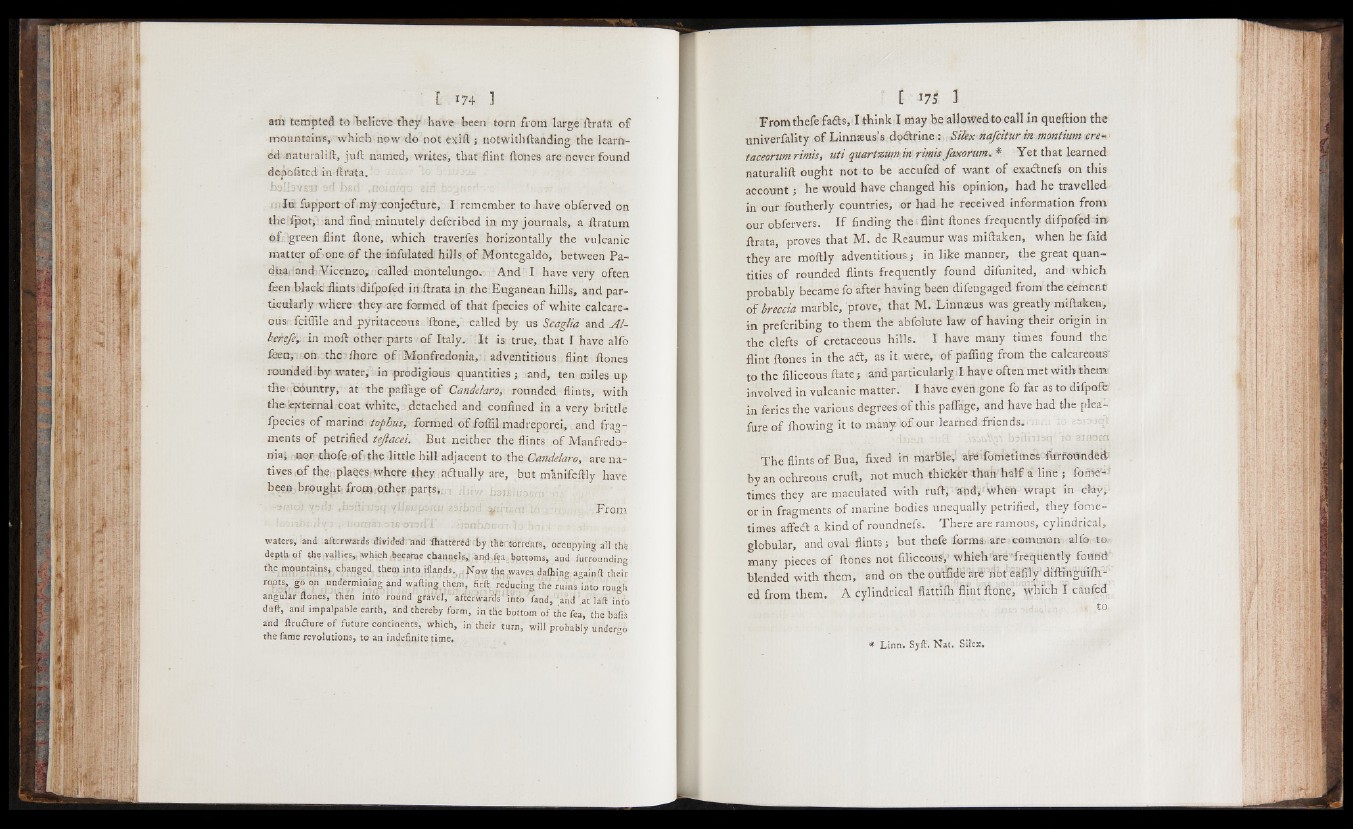
am tempted to believe they have been torn from large ftrata o f
mountains,' which now do not e x ift; notwith(landing the learned
natural id, juit named, writes, thatflint ñones are never found
depoiited in ftrata,
■ Mfupport o fm y xonjefture, I remember to-have obferved on
the'fpot, ■ and find minutely defcribed in my journals, a ñratum
©f£.dgreen flint ftone,. which traverfes horizontally the vulcanic
matter of-one o f the infulated hills o f Montegaldo, between Pa-
dun and Viecnzo, called montclungo. And I have very often
fcen black flints idifpofed in flrata in the:Euganean hills, and par-
ticuiarly where they are formed o f that fpecies o f white calcare-
ousn fciffile and pyritaceous ftone,' called by us Scaglia and A l-
berefe'y in moft other parts o f Italy. It is true, that I have alfo
feen, on the ihore o f Monfredonia, adventitious, flint ñones
rounded by water, in prodigious quantities ; and, ten miles up
the-Country, at the paffage o f Candelaro, rounded flints, with
the -external coat white, detached and confined in a very brittle
fpecies o f marine tophus, formed o ffg flil madreporei, and fragments
o f petrified tejlacei. But neither the flints o f Manfredo-
niaj aor- thofe o f the little hill adjacent to the Candelaro, are natives
(o f th^i i places, iw-here they aftually are, but mhnifeftly have
beep brought, from, other parfs,, ¡
From
w a te r s- , an d a f te rw a r d s divided t in d • ih a t fe r td '" b y th e t o r r e n t s , o c c u p y in g a l l this,
d e p th pf t h e .Y j j l i e s , , w h i c h -b e cjpn e c h a n n e l^ infbftaa and fp r r o u n d in g
th e m o u n ta ip s ,^ c h a p p e d , th en ) in tQ ii la n d s . , Np'.v t b f iw a v e ^ d a fh in g a g a in f t th e ir
r06a^r'S° É l Í É É ^ l f l n **>« ruinslnto rough
angular itohes, Ifien in ió ’ round gravel,' afterwan/i'into fand,:iahd :.at íaft ¡rifo
düft, and impalpable earth, and thereby form, in the bottom o f the Tea, the bafis
and ftrufture of future continents, which, in their turn, will probably uñdeWó
the fame revolutions, to an indefinite time.
From thefe fadts, I think I may be allowed to call in queftion the
univerfality o f Linnaeus’s dodtrine : Silex nafcitur in montium ere-
taceorum rimis, uti quarlzum in rimis faxorum. * Yet that learned
naturalift ought not to be accufed o f want o f exatftnefs on this
account; he would have changed his opinion, had he travelled
in our foutherly countries, or had he received information from
our obfervers. I f finding the I flint ftones frequently difpofed in,
ftrata, proves that M . de Reaumur was miftaken, when he faid
they are moftly adventitious ; in like manner, the great quantities
o f rounded flints frequently found difunited, and which
probably became fo after having been difengaged from the cement
of breccia marble/prove, that M. Linnams was greatly miftaken,
in prefcribing to them the abfolute law of having their origin in
the clefts o f cretaceous hills. I have many times found the
flint ftones in the aft, as it were, o f palling from the calcareous
to the filiceous ftate j and particularly I have often met with them
involved in vulcanic matter. I have eyed gone fo far as to difpofe
in feries the various degrees-of this paffage, and have had the plea-
fure o f ihowing it to many o f our learned friends.
The flints o f Bua, fixed in marble,! ate fometimes furfoUnded-
byanochreous cruft, not much thicker thah half a line ; fortYc-
times they are maculated with ruft, 'apdy When Wrapt in clayv
or in fragments o f marine bodies unequally petrified, they fome-
times affeft a kind o f roundnefs. There are ramous, cylindrical,
globular, and oval flints y but thefe fiarriMb.areaeomiMan: alfe-ts»
many pieces of ftones not filiceous^ whfeh%e'ffre?ifiently foUftdr
blended with them, and on the outflde’ki^'^t^afil^diftmgtfiili"
ed from them. A cylindrical flattilh flint'ftdpej wSich I caufed
I to.
* Linn. Syff. Nat. Silex*.